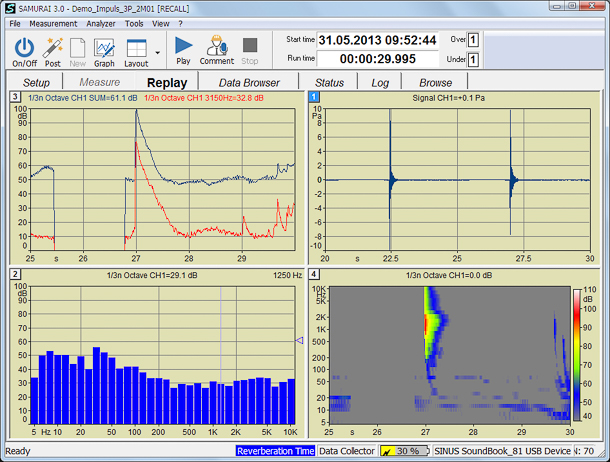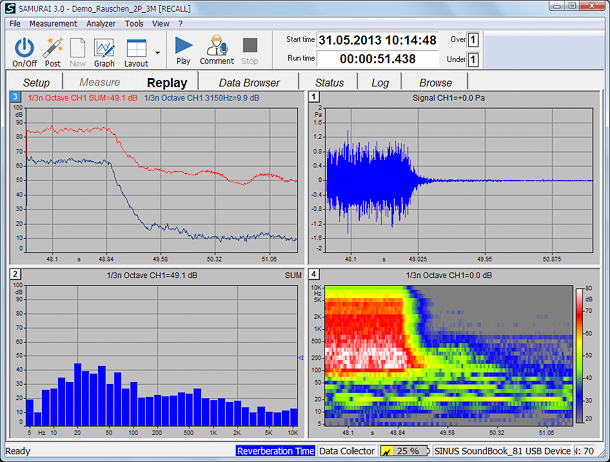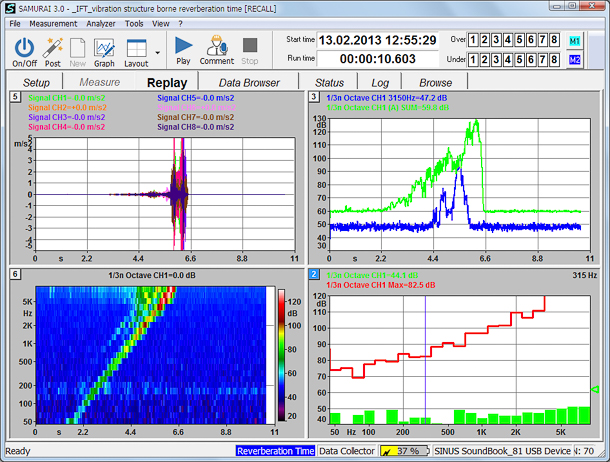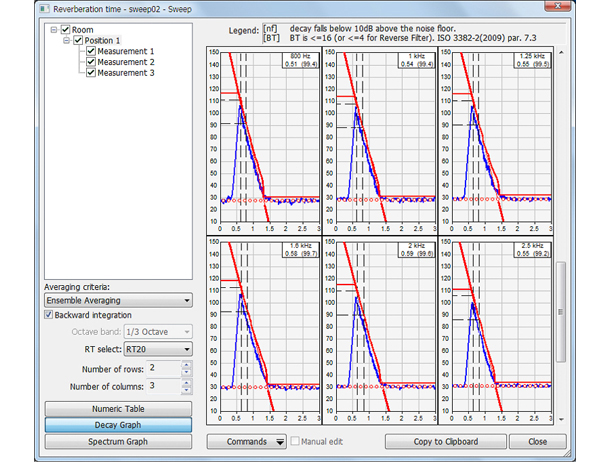Reverberation Time according DIN EN ISO 3382-2,
Structure borne reverberation time
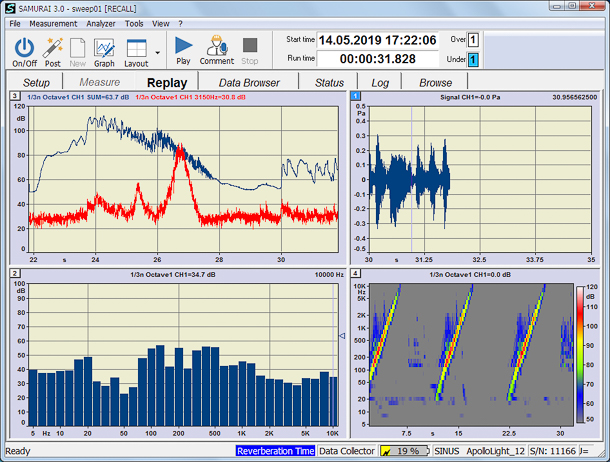
Übersicht
Applications
The reverberation time is used to analyze speech intelligibility and general acoustic perception in rooms. In addition, the reverberation time is required to correct reverberation effects in building acoustic measurements and sound power measurements and is therefore necessary for the following application:
Determination of parameters for room acoustics
The crucial parameter in terms of room acoustic planning and evaluation is the reverberation time of the room. It is used, for example, to assess audibility in rooms in accordance with DIN 18041.
Determination of the room correction for measurements in building acoustics
The reverberation time is required for sound insulation measurements in buildings to correct the absorption in the reception room in accordance with DIN EN ISO 16283 (buildings) and DIN EN ISO 10140 (test bench).
Determination of the room correction for sound power measurements
It is necessary to measure the sound power level of tools, household appliances and machines to be eligible for certain safety labels. When determining the sound power and sound energy levels of noise sources according to DIN EN 3744 - 46, the reverberation time is used to correct the effect of the measuring room. This is being considered by the K1 criterion for the suitability and correction of the measurement environment.
Determination of the sound absorption coefficient
The reverberation time is influenced by the sound absorption of the materials in a room. The difference of the reverberation times of a room with and without absorption material provides information about the calculated sound absorption values. The measurement of sound absorption in reverberation rooms is described in DIN EN ISO 354.
Description
The SAMURAI option Reverberation Time enables the measurement of the reverberation time with three excitations methods: impulse, sine sweep and switched off noise with an external noise signal or the integrated Apollo signal generator. The sine sweep and the switched off noise are part of this SAMURAI option.
The measurements can be made at different positions in the room, from which the average reverberation time for the room is calculated. A detailed evaluation according to ISO 3382-2, in which criteria such as BT> 16, noise floor, correlation coefficient, degree of curvature and standard deviation can be evaluated, enables a statement to be made about the quality or validity of the measurement results.
The reverberation time using the sine sweep excitation is acquired from the impulse response with backward integration and can be calculated in octave or third-octave bands over a user-defined frequency range. The measurement results are displayed as T15, T20, T30 and Early Decay Time (EDT) spectra of a single measurement and as an average of several measurements in a room. Using "Ensemble averaging" the resulting decay curves can be calculated from the averaged decay processes of the individual frequency bands. There is also the option of manually adjusting the regression line to the decay curve.
The Software offers the possibility to extend the reverberation time up to 80 kHz. This allows for example to simulate the sound absorption in model reverberation rooms with a scale 1:10. The frequency range of the measurement in the mentioned scale will be increased tenfold, which requires the measurement of the reverberation time in a higher frequency range. The expected measured reverberation time in the empty model room should be about ten times shorter than in the original reverberation room.
Illustration 1:
Reverberation time measurement with pulse excitation. During the measurement, the time signal, the octave spectrum of the active measuring channels and the level history of the spectra can be displayed as a curve of level sums or individual octavescan be displayed.
Illustration 2:
Reverberation time measurement with switched off noise. The noise signal can be generated by an external source or the integrated signal generator of SAMURAI using the Apollo hardware.
Illustration 3:
Reverberation time measurement with sine sweep excitation. The results are calculated from the impulse response using backward integration.
Illustration 4:
Measurement of structure-borne noise reverberation time for measurements according DIN EN ISO 10848-1. In this measurement, eight accelerometers were attached to the measurement object. A small shaker and a sweep signal from the Apollo analyser were used as excitation source.
Illustration 5:
Evaluation of the reverberation time. This figure shows the averaged decay curves of the individual frequency bands and positions from three individual measurements.
Standards and approvals
Standards
DIN EN ISO 3382-2 Acoustics - Measurement of room acoustic parameters - Part 2: Reverberation time in ordinary rooms
Feature
Requirements
This software option require a valid SAMURAI_base license.



